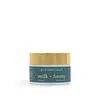What's inside
What's inside
 Key Ingredients
Key Ingredients

No key ingredients
 Benefits
Benefits

 Concerns
Concerns

 Ingredients Side-by-side
Ingredients Side-by-side

Sclerocarya Birrea Seed Oil
HumectantSimmondsia Chinensis Seed Oil
EmollientPlukenetia Volubilis Seed Oil
EmollientHelianthus Annuus Seed Oil
EmollientRosa Canina Fruit Oil
EmollientCitrullus Lanatus Seed Oil
EmollientSalvia Hispanica Seed Oil
MoisturisingTanacetum Annuum Flower Oil
MaskingOpuntia Ficus-Indica Seed Oil
EmollientAnthemis Nobilis Flower Oil
MaskingAchillea Millefolium Oil
CleansingRosmarinus Officinalis Extract
AntimicrobialHelianthus Annuus Seed Extract
Skin ConditioningButyrospermum Parkii Butter
Skin ConditioningTheobroma Cacao Seed Butter
EmollientOryza Sativa Bran Extract
Skin ConditioningTocopherol
AntioxidantSclerocarya Birrea Seed Oil, Simmondsia Chinensis Seed Oil, Plukenetia Volubilis Seed Oil, Helianthus Annuus Seed Oil, Rosa Canina Fruit Oil, Citrullus Lanatus Seed Oil, Salvia Hispanica Seed Oil, Tanacetum Annuum Flower Oil, Opuntia Ficus-Indica Seed Oil, Anthemis Nobilis Flower Oil, Achillea Millefolium Oil, Rosmarinus Officinalis Extract, Helianthus Annuus Seed Extract, Butyrospermum Parkii Butter, Theobroma Cacao Seed Butter, Oryza Sativa Bran Extract, Tocopherol
Ingredients Explained
These ingredients are found in both products.
Ingredients higher up in an ingredient list are typically present in a larger amount.
This ingredient is also known as shea butter. It is an effective skin hydrator and emollient.
Emollients help soothe and soften your skin. It does this by creating a protective film on your skin. This barrier helps trap moisture and keeps your skin hydrated. Emollients may be effective at treating dry or itchy skin.
Shea butter is rich in antioxidants. Antioxidants help fight free-radicals, or molecules that may harm the body. It is also full of fatty acids including stearic acid and linoleic acid. These acids help replenish the skin and keep skin moisturized.
While Shea Butter has an SPF rating of about 3-4, it is not a sunscreen replacement.
Shea butter may not be fungal acne safe. We recommend speaking with a professional if you have any concerns.
Learn more about Butyrospermum Parkii ButterThis oil comes from the seed of the prickly pear cactus. Due to its ability to be easily absorbed, it does not leave a greasy feeling behind.
The main parts of this oil are fatty acids - linoleic, oleic, and palmitic. Other than that, the seeds also contains antioxidants such as vitamin E that help soothe the skin.
Due to its fatty acid content, this ingredient may not be fungal-acne safe.
Learn more about Opuntia Ficus-Indica Seed OilThis oil comes from the seeds of the desert shrub called Jojoba. It is more commonly known as jojoba oil, a non-comedogenic oil.
Jojoba oil does not contain fragrance and has many fatty-acids, making it a great soothing ingredient.
It also contains Vitamin E, a great moisturizing ingredient. Vitamin E is also an antioxidant and protects your skin against oxidative damage.
This ingredient humectant properties, meaning it helps draw moisture from the air. This helps keep your skin hydrated.
While jojoba has antibacterial properties, it is only able to kill some strains of bacteria.
Studies also show it helps in wound healing. In fact, Indigenous cultures have used jojoba as a moisturizer and to help treat burns for centuries.
Fun fact: Jojoba oil similar to natural human skin sebum, so it has a great effect on dry skin. It is also promising with helping to regulate sebum production.
Due to its fatty acid content, Jojoba oil may not be fungal acne safe. We recommend speaking with a professional if you have any concerns.
Learn more about Simmondsia Chinensis Seed OilBlue tansy is a blue flower native to the Mediterranean. It has antioxidant, skin cooling, and perfuming properties.
This ingredient is currently being studied for its antifungal properties. While it does have antioxidant benefits - it may not be the best for sensitive skin (despite being advertised as so).
The cooling effect from blue tansy comes from its camphor content. Camphor is known to induce irritation in concentrations higher than 11%. It also contains another skin irritant, beta-pinene.
Learn more about Tanacetum Annuum Flower OilTheobroma Cacao Seed Butter comes from the Theobroma cacoa, or Cacao tree. Cacao trees are native to tropical landscapes.
Like other plant butters, Cacao seed butter is an emollient. Emollients help soothe and soften your skin. By creating a barrier to trap moisture in, emollients help keep your skin hydrated.
Cacao seed butter contains antioxidants known as polyphenols. Antioxidants help fight free-radical molecules by stabilizing them. Unstable free-radicals may cause damage to your skin cells. Antioxidants may help with anti-aging.
Theobroma Cacao Seed Butter can be bad for acne prone skin.
Learn more about Theobroma Cacao Seed Butter